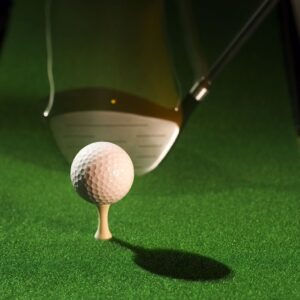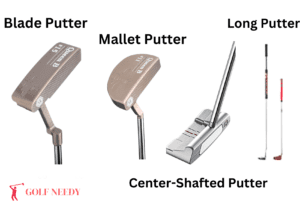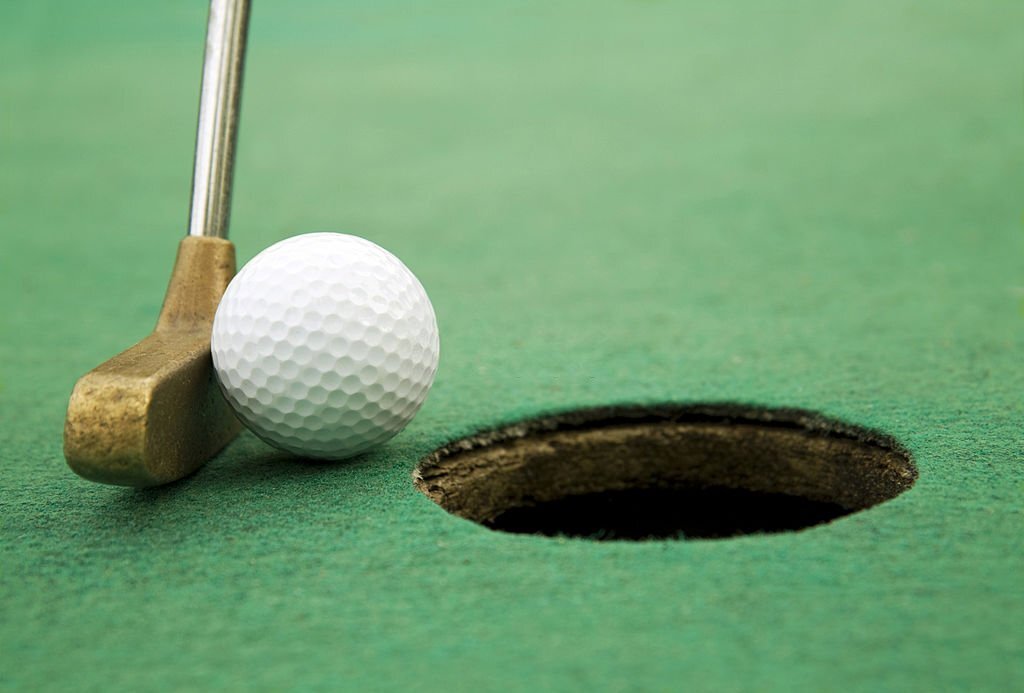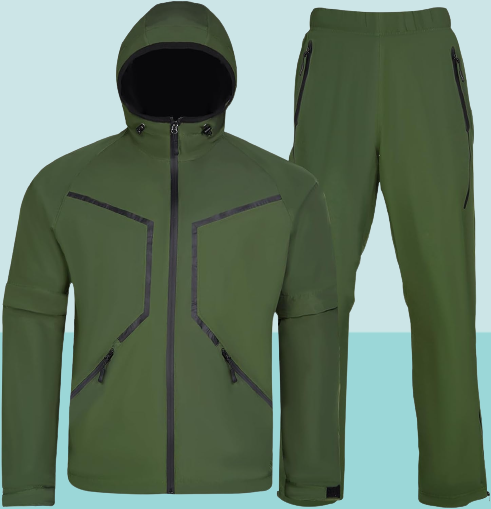Golf Puttersasts know that a putter is one of the most important clubs in a golfer’s bag. As the name suggests, this club is used for putting, which is the final stroke taken on the green before the ball enters the hole. But what is a putter in golf, and what is its primary purpose?
In this article, we’ll explore the ins and outs of putters, including how they work, the different types available, and how to choose the right one for your game. Whether you’re a seasoned pro or just starting out, understanding the role of the putter in golf is key to improving your overall game.
What is a Putter and How Does it Work?

A putter is a golf club with a flat-faced head, usually made of metal, attached to a shaft. Its primary purpose is to roll the ball smoothly and accurately along the green toward the hole during the putting stroke. While other clubs are designed for distance and elevation, the putter’s focus is on finesse and accuracy.
A putter is a club used in golf to roll the ball along the ground on the putting green. Unlike other clubs used in golf, a putter has a flat face and is designed to keep the ball rolling along the ground smoothly. The primary purpose of a putter is to get the ball into the hole with as few strokes as possible.
Key Components of a Putter and Their Functions
A putter is comprised of several key components, each playing a crucial role in its performance on the green. Let’s explore these components and their functions:
- Head: The putter head is the primary striking surface. It features a flat face that ensures clean contact with the golf ball, promoting a smooth roll toward the hole.
- Face: The face of a putter often incorporates special textures or inserts to enhance grip and minimize skidding. Grooves or milled patterns on the face help impart topspin on the ball for a truer roll.
- Hosel: The hosel connects the putter head to the shaft. It influences the balance and feel of the putter. Hosels can be heel-shafted or center-shafted, altering the weight distribution and the golfer’s perception of the putter’s movement.
- Shaft: The shaft is the long, slender tube that connects the grip to the putter head. It provides stability and leverage, allowing for a controlled and consistent putting stroke. Shaft length can vary to accommodate different preferences and putting styles.
- Grip: The grip is the handle of the putter that golfers hold during their stroke. It ensures a comfortable and secure hold while maintaining control over the putter head. Grip materials and shapes can vary to suit individual preferences.
By understanding the functions of these key components, golfers can make informed decisions when selecting a putter that suits their style and preferences. The design and quality of these components greatly contribute to the performance and effectiveness of a putter on the greens.
What Makes a Putter Different from Other Golf Clubs
One of the main differences between a putter and other clubs used in golf is the design of the club head. A putter has a flat face that is designed to roll the ball along the ground, whereas other clubs, such as drivers, have a curved face that is designed to lift the ball into the air. Additionally, putters are typically shorter than other clubs, which allows for better control and accuracy when putting. The design of the putter makes it ideal for short-range shots on the green where accuracy and precision are essential.
The History of Putters in Golf
The putter has a long and interesting history in the sport of golf. The first putters were made from wood, with a simple design consisting of a wooden shaft and a small, flat head. As the sport evolved, so too did the design of putters. In the early 1900s, putters with metal heads began to appear, which were more durable and allowed for more consistent shots. By the 1920s, putters with offset shafts and mallet-shaped heads were introduced, which provided golfers with more options for their putting game.
One of the most significant innovations in putter design came in the 1950s, with the introduction of perimeter-weighted putters. These putters were designed to distribute the weight of the clubhead around the perimeter of the head, which helped to increase stability and accuracy when putting. This innovation led to the development of modern putters that use advanced materials and designs to improve putting performance.
Today, there are countless variations of putter design, each with its own unique features and benefits. From traditional blade putters to high-tech mallet putters, golfers have a wide range of options to choose from when selecting a putter for their game. As technology continues to advance, we can expect to see even more exciting developments in putter design and performance.
Different Types of Putters

There are several different types of putters available, each with its own unique design and purpose. Here are some of the most common types:
Blade Putters
Blade putters have a thin, blade-like head and a simple, classic design. They are typically made of metal and are ideal for golfers who prefer a traditional look and feel. Blade putters are generally less forgiving than other types of putters, but can provide better feel and control over putts.
Mallet Putters
Mallet putters have a larger, more rounded head than blade putters. They are designed to be more forgiving and are ideal for golfers who struggle with accuracy when putting. Mallet putters can be made of a variety of materials, including metal, wood, and plastic. Some mallet putters also have alignment aids, which can help golfers line up their shots more accurately.
Center-Shafted Putters
Center-shafted putters have the shaft positioned in the center of the clubhead. This design allows for better alignment and is ideal for golfers who struggle with accuracy when putting. Center-shafted putters can be found in both blade and mallet designs.
Face-Balanced Putters
Face-balanced putters have a clubhead that is balanced to stay square to the target line throughout the stroke. This can help golfers achieve a more consistent, reliable putting stroke. Face-balanced putters can be found in both blade and mallet designs.
Toe-Weighted Putters
Toe-weighted putters have extra weight in the toe of the clubhead, which helps to improve stability and accuracy when putting. This design is ideal for golfers who tend to push or pull their putts. Toe-weighted putters can be found in both blade and mallet designs.
Long Putters
Long putters, also known as belly putters or broomstick putters, have an extended shaft that is anchored to the golfer’s body. This design can help golfers achieve a smoother, more consistent putting stroke. Long putters are generally used by golfers who struggle with traditional putting techniques.
By understanding the different types of putters available, you can choose the one that best suits your individual preferences and playing style.
RELATED: Golf Driver Buying Guide 2023-Things You Should Know First
How to Choose the Right Putter for Your Game

Choosing the right putter is crucial to improving your golf game. Here are some factors to consider when selecting a putter:
1. Length
The length of the putter is an important factor to consider. A putter that is too long or too short can affect your stance and alignment, which in turn can affect your putting performance. When selecting a putter, make sure to choose one that is appropriate for your height and stance.
2. Weight
The weight of the putter is also important. A putter that is too heavy or light can affect your swing and control. It’s important to choose a putter that feels comfortable for you to swing and provides the right amount of feel. Consider different weights until you find the one that feels the most natural to you.
3. Type of Putter
There are several types of putters available, each with its own unique design and purpose. Consider the type of putter that best suits your playing style and skill level.
- Blade putters: These putters have a traditional, streamlined design with a small clubhead and a straight shaft. They are favored by golfers who prefer a more traditional look and feel.
- Mallet putters: These putters have a larger, more rounded clubhead and a more complex design. They are favored by golfers who prefer a more modern, technologically advanced look and feel.
- Center-shafted putters: These putters have the shaft located at the center of the club head, which helps to create a more balanced stroke.
- Face-balanced putters: These putters have a club head that is balanced to stay square to the target line throughout the stroke. They are favored by golfers who prefer a more consistent, reliable stroke.
Consider your putting style and needs when deciding which type of putter to choose.
4. Budget
Putters can range in price from less than $50 to several hundred dollars. While a higher price doesn’t always guarantee better performance, it’s important to consider your budget when selecting a putter.
By considering these factors and testing different putters, you can find the right putter for your game and improve your putting performance on the course.
How to Use a Putter
Using a putter correctly is essential to improving your golf game. Here are some tips for using a putter effectively:
1. Grip the Club Correctly
Place your hands on the grip of the putter with your thumbs pointing straight down the shaft. Your grip should be firm but not too tight. Make sure your hands are not too close or too far apart on the club.
2. Address the Ball
Stand with your feet shoulder-width apart and position the ball in the center of your stance. Align the putter face with the ball and your target. Your body should be parallel to the target line.
3. Take Your Stance
Your stance should be comfortable and balanced, with your weight evenly distributed between your feet. Your feet should be shoulder-width apart, and your knees should be slightly flexed. Avoid leaning too far forward or backward.
4. Make Your Stroke
Keep your head still and your eyes focused on the ball. Use a smooth, pendulum-like motion to roll the ball towards the hole. When making your stroke, keep your arms and wrists relaxed. Avoid using too much force or trying to scoop the ball.
5. Follow Through
After making contact with the ball, continue your stroke towards the hole. Avoid lifting your head too soon or taking your eyes off the ball. Follow through with your swing and allow the putter to swing naturally.
RELATED: how does the design of a putter affect a golfer’s putting stroke?
Putter Accessories
Accessories can help golfers improve their putting game and take better care of their putters. Here are some of the most common putter accessories and their functions:
Putter Grips
Putter grips are an essential accessory that can significantly impact a golfer’s performance. They come in a range of materials, textures, and designs to suit individual preferences. Some putter grips have a soft, tacky feel that provides a comfortable and secure hold on the club, while others have a firmer texture for increased control. Choosing the right putter grip can improve your feel for the club and help you make more accurate putts.
Alignment Aids
Alignment aids are tools that can help golfers improve their alignment and accuracy when putting. They include putting mirrors, laser pointers, and alignment sticks. A putting mirror allows golfers to see their alignment and posture from different angles, while a laser pointer projects a line onto the putting surface to help golfers aim. Alignment sticks are long, thin rods that can be placed on the ground to create a visual guide for putting. Using alignment aids can help golfers improve their stroke and make more consistent putts.
Headcovers
Headcovers are designed to protect the clubhead from damage during transport and storage. They come in a range of materials, including neoprene, leather, and synthetic materials. Headcovers can help extend the life of your putter by preventing scratches, dents, and other types of damage. They can also help keep your putter looking new and in top condition.
Maintaining and Caring for Your Putter
Proper maintenance and care can help prolong the life of your putter and ensure that it performs at its best. Here are some tips for maintaining and caring for your putter:
1. Clean your putter after each use
Cleaning your putter after each use is important to prevent dirt and debris from building up on the club head and grip. Use a soft, damp cloth to wipe down the club head and grip, and then dry the putter thoroughly with a towel to prevent rust and corrosion.
2. Store your putter properly
Storing your putter properly is essential to protect it from damage and keep it in good condition. Keep your putter in a cool, dry place, away from direct sunlight and moisture. Use a headcover to protect the clubhead and prevent scratches or dents.
3. Replace worn-out grips
Over time, the grip on your putter may become worn or damaged. This can affect your grip and control over the club, leading to inaccurate shots. If your putter grip becomes worn or damaged, it’s important to replace it as soon as possible to maintain optimal performance.
4. Replace your putter when necessary
If your putter becomes damaged or worn out, it may be time to replace it. Signs that your putter may need to be replaced include cracks or dents in the clubhead, a loose or damaged shaft, or a worn-out grip that cannot be replaced. When choosing a new putter, be sure to consider factors such as length, weight, and style to ensure that it meets your individual needs and playing style.
By following these tips for maintaining and caring for your putter, you can ensure that it performs at its best for years to come.
5 Interesting Facts About Golf Putters
- The first putters were made of wood, and some early versions had a hole in the middle of the head so that the golfer could see the ball through it.
- The term “putter” is derived from the verb “to putt,” which means to gently place or roll an object. This is fitting, since the primary purpose of a putter is to roll the golf ball into the hole.
- There are many different types of putters available, each with its own unique design and features. Some popular putter head designs include blade putters, mallet putters, and heel-toe weighted putters.
- Putters can be made from a variety of materials, including metal, wood, and plastic. Some putters also feature inserts made of materials like polymer or elastomer to enhance feel and control.
- The length of a putter can be adjusted to accommodate a golfer’s height, posture, and stroke style. This customization allows players to find the ideal length that promotes proper alignment, balance, and comfort during their putting stroke.
Frequently Asked Questions About Putters
Here are some common questions about putters:
What is the best putter for beginners?
For beginners, a mallet putter with a larger clubhead and more forgiveness is often a good choice. This type of putter is designed to help golfers make more accurate shots, even if they don’t hit the ball exactly in the center of the clubface. Some popular mallet putters for beginners include the TaylorMade Spider and the Odyssey O-Works.
How does putter length affect performance?
Putter length can affect your stance and alignment, which in turn can affect your putting performance. It’s important to choose a putter length that is appropriate for your height and stance. A putter that is too short can cause you to hunch over the ball, while a putter that is too long can cause you to stand too upright. Ideally, your putter should allow you to maintain a comfortable, natural stance throughout your stroke.
What is the difference between a blade putter and a mallet putter?
Blade putters have a thin, blade-like head and are more traditional in design. They are favored by golfers who prefer a simple, clean look and feel. Mallet putters have a larger, more rounded head and are designed to be more forgiving. They are favored by golfers who prefer a more modern, technologically advanced look and feel. Ultimately, the right choice will depend on your individual preferences and playing style.
Conclusion
In conclusion, a putter is a crucial component in a golfer’s gameplay. It is specifically designed to roll the ball along the ground on the putting green, making it a vital tool for achieving your goal of getting the ball into the hole with the least amount of strokes possible. By understanding the different types of putters available, how to use a putter effectively, and how to care for your putter, you can improve your golf game and become a more skilled putter.
When choosing a putter, take into consideration factors such as length, weight, and type of putter. Keep in mind that the right putter for you may not be the most expensive one on the market. With regular practice and proper maintenance, you can improve your putting skills and enjoy the game of golf even more.
Remember, putting is a skill that takes time and effort to master. But with the tips and insights provided in this article, you’ll be well on your way to becoming a proficient putter and improving your overall golf game. Happy golfing!

I’m Donna Weiss, and I am the proud writer behind the captivating content you’ll find on golfneedy.com. As an avid golfer and passionate writer, I have combined my two greatest passions to bring you an incredible golfing experience. Through my articles, I aim to provide you with valuable insights, equipment reviews, and updates on the latest tournaments. Whether you’re a seasoned golfer or just starting out on this exciting journey, I am here to guide you and share my expertise. Together, let’s explore the fascinating world of golf, uncovering new techniques, and enhancing our skills. Join me on this thrilling adventure as we elevate our game and embark on an exciting golfing journey. Read More



